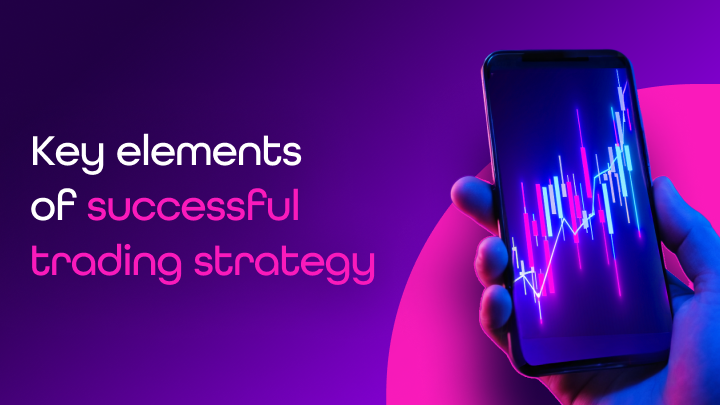How to develop a trading strategy that actually works
Having a trading strategy is what differentiates a trader from a gambler. If you’re serious about trading, you’ll need one. Luckily for you, tips in this article will help you with that.

If you’re serious about trading, stop winging it. Whether you’re a complete beginner or already placing trades, you need a trading strategy. Think of it as your blueprint. Your compass. Your shield against chaos.
Without a plan, you’re just gambling. With a solid strategy? You’re building something real.
This guide will walk you through everything you need to know to develop your own trading strategy, choose the ideal trading instruments, and avoid common pitfalls—step by step.
Before we start, let’s make things clear
There’s no perfect, magical, one-size-fits-all strategy that’ll guarantee legendary profits. That “holy grail” everyone talks about? It doesn’t exist. The truth? Any solid trading strategy can work—if you work on yourself. Your mindset is the real edge. Sticking to your plan. Staying disciplined. Taking losses like a pro and not jumping ship when things get shaky. That’s what separates real traders from hopeful gamblers. You are the main variable. Not the strategy. Not the indicators. You.
What is a trading strategy?
A trading strategy is your personalized game plan for how you’ll approach the market. It outlines:
- What assets you’ll trade
- When you enter and exit trades
- How much risk you’ll take
- Which analysis method you use (technical, fundamental, or both)
- How you’ll react to changing market conditions
And here’s the kicker—it’s not just about rules. A good strategy supports your psychology, manages your emotions, and helps you stay consistent no matter what the markets throw at you.
Whether you’re into crypto, commodities, or a forex trading strategy, the structure is the same. Planning beats guessing—every time.
Why trading strategies matter
Imagine driving a car with no brakes and no steering wheel. That’s what trading without a strategy feels like.
A good trading strategy helps you:
- Know exactly when to enter and exit
- Manage your risk with tools like the best stop loss strategy
- Select the right trading instruments for your style
- Stick to a routine, even when markets go wild
- Block out the noise and avoid emotional decisions
Your trading success doesn’t come from hype—it comes from discipline. And discipline starts with a strategy.
Choose your trading style
The first step in building a strategy? Know your style. Here’s a breakdown of the most common types:
Scalping strategies
Scalping is for speed demons.
- Timeframes: M1–M5
- Trades last seconds to minutes
- You’re looking for small price movements with high frequency
- Works best during high-volatility hours (like EU and US session opens)
- Requires focus, fast execution, and lots of screen time
Best for: Experienced traders who love fast-paced action and tight spreads.
Intraday trading strategies
Also known as day trading. You open and close all trades within the same day.
- Timeframes: M15–H1
- Trades last minutes to hours
- You avoid overnight risk and swap fees
- You may use higher timeframes (H4, D1) to analyze the trend and lower ones to time your entries
Best for: Traders who want structure and daily progress without the stress of overnight exposure.
Swing trading strategies
Are you a student or got a full-time job? This one’s for you.
- Trades last overnight, sometimes up to several weeks
- You aim to capture larger market trends
- Lower trade frequency but higher reward-to-risk
- You need patience—and nerves of steel (to endure unprofitable days, or sideways market)
- Watch out for swaps (overnight holding fees)
Some traders find it hard to sleep with open positions. If that’s you, set alerts, use stop losses, and trust your analysis.
Best for: Beginners and part-time traders who prefer a slower, more thoughtful pace.
Decide how you’ll analyze the market
You’ve got two main weapons in your trader toolbox: technical analysis and fundamental analysis. Let’s break them down:
Technical analysis strategies (or price action)
Technical traders believe that price reflects everything.
- You analyze chart patterns, support/resistance, and indicators
- You look at candlestick formations, Fibonacci levels, moving averages, etc.
- Past behavior gives clues about what might happen next
For example, spotting a double bottom reversal chart pattern on EURUSD? That could be your next big hint that the market will possibly turn the other way soon.
Best for: Visual learners who love charts and patterns. Common in many forex strategies.
Fundamental strategies
You’re not staring at charts—you’re reading economic news.
- You react to macro events: inflation reports, interest rate decisions, central bank meetings, and even geopolitical tensions
- You use economic calendars to anticipate high-impact events
- Example: A surprise interest rate hike? That could move the USD fast
Some forex trade ideas are entirely built around scheduled news releases.
Best for: Traders who love global economics and can handle quick reactions to news spikes.
Market-specific trading strategies
Different markets = different rules of the game. Choose your battlefield wisely.
💱 Forex trading strategy
- High liquidity
- Runs 24/5
- Major, minor, and exotic currency pairs
- Pairs like EURUSD, GBPJPY, and USDJPY offer endless setups
- Combine technical patterns with fundamental catalysts for top-tier forex trade ideas
🥇Gold trading strategies
- Gold (XAUUSD) acts as a safe-haven asset
- Strongly impacted by inflation, interest rates, and risk sentiment
- Can spike quickly—watch those support/resistance zones
- Certain instruments correlate with gold; be sure to watch them for a more precise analysis!
- Gold swing trading strategies are great for beginner traders
📈 Stock trading strategies
- News and earnings drive price moves
- Strategy = combine technical chart setups with earnings calendars
- Swing trading is especially popular in stocks
🧠 Smart Money Concepts (SMC)
Want to trade like the big players? SMC strategies in forex teach you to:
- Spot liquidity grabs
- Recognize order blocks
- Understand institutional footprints
SMC is advanced but powerful if you’re ready for the next level.
Tools to boost your trading strategy
Here’s what every pro trader swears by:
📋 The trading plan
Your plan is the map. It answers:
- What will I trade?
- When will I trade it?
- What happens if A doesn’t go as planned—do I switch to Plan B?
It’s your checklist. Your anchor. Follow it religiously. Hit your daily goal (like 1R or 0.5%)? You’re done. Walk away. Celebrate small wins. That’s how consistency is built. And yeah, revenge trading and other mental traps? The plan helps you block that too.
💡 Fintokei tip
Wondering which Fintokei challenge should you choose? StartTrader comes with built-in consistency rules—so overtrading is off the table. Each trading day has a clear, firm profit target. Once you hit it, you’re done for the day. You’ve done your job. Now it’s time to rest, recharge, and come back stronger tomorrow.
📖 The trading diary
Wanna coach yourself for free? Start journaling.
- Log every trade (symbol, setup, emotions, outcome)
- Review weekly or monthly
- Find patterns in your wins and losses
- Improve your trading psychology over time
It’s not glamorous, but it’s game-changing. Over time, you’ll understand yourself, and that’s your biggest trading edge.
Final thoughts
No one’s born with a killer strategy. But you can build one.
✅ Define your trading style
✅ Choose your market and instruments
✅ Build a trading plan
✅ Stay consistent
✅ Learn from your mistakes
The best traders are those who adapt, evolve, and keep showing up. Your trading strategy will change over time—and that’s a good thing. Stay flexible, and always be learning.
And remember: even the best trading strategy won’t save a bad mindset. But a good strategy paired with a strong mindset? That’s your ticket to long-term success.



